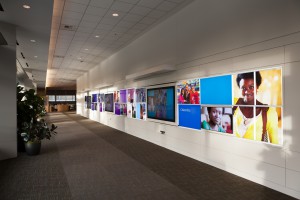In December 2013 Microsoft Netherlands organized the Lead Enterprise Architect Program (LEAP). A group of architects and Chief Technology Officer’s travelled to Seattle to follow the LEAP programm on the campus at the headquarters of Microsoft in Redmond.
This blog isn’t very comprehensive because at the start of the LEAP programm everyone had to sign a NDA. Not all of the information that Microsoft gave during LEAP can be made public. This blog is limited to the main lines of the content that could be published in public.
There was a traditional start with a keynote. Ulrich Homann, Chief Architect Worldwide Services, is responsible for the keynote. An important industry trend is the main topic: accelerating innovation. Of course there is a direct link to the 6th Computing Model, also known as Cloud Computing and also ‘the era after Cloud Computing’. Microsoft has given Cloud Computing priority for years. Because of this trend, products get released in the Cloud first and then on-premise (Cloud first deployment vs. Enterprise deployment). Microsoft’s datacenters are very important as the foundation infrastructure for Cloud Services. The datacenters that Microsoft has are based on the ‘non-reliable’ principal. So extremely cheap hardware and everything is controlled by software. In the keynote some numbers were mentioned concerning IaaS: Microsoft has release ca. 1,2 million Virtual Machines on Azure IaaS in 2013. According to Microsoft Amazon has release ca. 800.000 Virtual Machines on her IaaS platform in 2013 and Google ca. 1,8 million. Microsoft expects that in 2017 there will be ca. 5 million VM’s active on Azure IaaS. Microsoft has to change her whole organisation model in connection with the Cloud. Microsoft was used to launch new products every 3 year. With Azure there is a new release every 4 weeks and new functionality in introduced every 3 months. This speeds asks for a new method, a different organisation, etc. Microsoft points out that customers can’t keep up with this speed and that that’s why an Enterprise deployment (on-premise) are not getting updated at the same speed as in Azure. Modularity & singularity of code branches are key factors. There is disengagement and parts get their own code and own update patterns. Otherwise it is impossible to develop so quickly. It is also about testing and management. For this, Microsoft uses the method DevOps and learns according to Ulrich daily.
During LEAP limited information is shared about the roadmap. This has nothing to do with the NDA or something similar and also not because of the fact that Microsoft wouldn’t want it. There isn’t much roadmap information available. This has to do with the, as mentioned above, speed of development and releases. In the past Microsoft was able to present a roadmap for a couple of years, but with Cloud Computing a roadmap is outdated the moment it gets released. Instead of roadmaps Microsoft will release so called ‘investment guides’. These are areas which Microsoft will focus on for the coming period. Ulrich points out that strategies and architectures do not change that quickly and that Microsoft does hold onto this. So core principles. Microsoft Consulting Services (MCS) and Microsoft Product Support Services (PSS) are still making a ‘journey’ considering the adaptation of new technology and features in the Cloud. Ulrich recommends to follow MDSN and TechNet. These are the resources that are the most up-to-date. MCS and PSS are also using these at the moment.
Microsoft gives her vision on business such as The Internet of Things, Consumerization and Big Data. To support this a few impressive numbers are given. Microsoft also refers to the paper of Steve Ballmer in which he goes into the changes that Microsoft goes through to an organisation that focusses on Devices & Services. Microsoft goes into the subject Big Data and is talking about the ‘API economy’. It’s about the integration of devices, services, etc. Also among themselves. This is, concerning Microsoft, not even close to what it should be. Bill Buxton, principal researcher at Microsoft research, also goes into this. Unfortunately under NDA.
Eduardo Kassner, Principal Datacenter Modernizations, hold the known story about ‘The Modern Datacenter’. Or also known as Private, Public and Hybrid Cloud. Through some catchy metaphors he points out how datacenters have grown the last few years but that nothing is actually solved. There has only come more as of hard- and software and it has become more complex. Not more flexible, cheaper, more scalable, etc. It’s according to Eduardo not about ‘buying’ something but about adding ‘value’. Next to Azure IaaS Hyper-V and System Center are also discussed thoroughly. Not only the products but also the architecture. For the hybrid cloud the Windows Azure Pack is enlightened. The importance of Powershell is also explained.
Unfortunately, not many new information in this blog because of the NDA.

